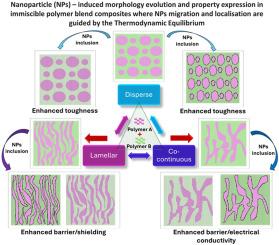Our official English website, www.x-mol.net, welcomes your
feedback! (Note: you will need to create a separate account there.)
Nanoparticle-induced morphology evolution and property expression in immiscible polymer blend composites−A review of fundamental understanding on nanoparticle migration and interface crossing
Polymer ( IF 4.1 ) Pub Date : 2024-11-15 , DOI: 10.1016/j.polymer.2024.127844 Ritima Banerjee, Yongjin Li, Suprakas Sinha Ray
Polymer ( IF 4.1 ) Pub Date : 2024-11-15 , DOI: 10.1016/j.polymer.2024.127844 Ritima Banerjee, Yongjin Li, Suprakas Sinha Ray

|
This article provides a critical overview of the fundamentals related to the migration and localization of nanoparticles in immiscible polymer blends, with a discussion on recent advances, including knowledge gaps related to the effect of nanofiller localization on the properties of polymer blend composites. Thermodynamic equilibrium primarily guides the migration and localization of nanoparticles in immiscible polymer blends. However, the effect of kinetics cannot be ignored when nanoparticles are initially distributed in a thermodynamically less favored phase. By controlling various process parameters during melt processing, one can exploit the effect of kinetics for tailoring the localization of nanoparticles. Furthermore, filler particles can be localized at the interface by surface modification of the filler particles and inducing interfacial reactions or by tailoring their wettability using surface functionalization. Such control of the migration of nanoparticles is crucial for getting desired properties, such as high electrical conductivity and low percolation threshold of conductive polymer blend nanocomposites. By providing a holistic understanding of all critical aspects (thermodynamic and kinetic) related to the control of migration of all commonly used nanoparticles and its subsequent effect on properties, this review offers a direction for future advances in the development of high-performance multiphase nanocomposite materials used for various high-end applications.
中文翻译:

纳米颗粒诱导的不混溶聚合物共混复合材料的形貌演变和性能表达 - 对纳米颗粒迁移和界面交叉的基本认识综述
本文对与不混溶聚合物共混物中纳米颗粒的迁移和定位相关的基本原理进行了批判性概述,并讨论了最近的进展,包括与纳米填料定位对聚合物共混复合材料性能的影响相关的知识差距。热力学平衡主要指导纳米颗粒在不混溶聚合物共混物中的迁移和定位。然而,当纳米颗粒最初分布在热力学上不太有利的相中时,动力学的影响不能被忽视。通过控制熔融加工过程中的各种工艺参数,可以利用动力学的影响来定制纳米颗粒的定位。此外,填料颗粒可以通过填料颗粒的表面改性和诱导界面反应,或者通过使用表面功能化来定制其润湿性,从而在界面上定位填料颗粒。这种对纳米颗粒迁移的控制对于获得所需的性能至关重要,例如导电聚合物共混纳米复合材料的高导电性和低渗流阈值。通过提供对所有常用纳米颗粒迁移控制及其对性能的后续影响相关的所有关键方面(热力学和动力学)的整体理解,本文为用于各种高端应用的高性能多相纳米复合材料的开发提供了未来进展的方向。
更新日期:2024-11-15
中文翻译:

纳米颗粒诱导的不混溶聚合物共混复合材料的形貌演变和性能表达 - 对纳米颗粒迁移和界面交叉的基本认识综述
本文对与不混溶聚合物共混物中纳米颗粒的迁移和定位相关的基本原理进行了批判性概述,并讨论了最近的进展,包括与纳米填料定位对聚合物共混复合材料性能的影响相关的知识差距。热力学平衡主要指导纳米颗粒在不混溶聚合物共混物中的迁移和定位。然而,当纳米颗粒最初分布在热力学上不太有利的相中时,动力学的影响不能被忽视。通过控制熔融加工过程中的各种工艺参数,可以利用动力学的影响来定制纳米颗粒的定位。此外,填料颗粒可以通过填料颗粒的表面改性和诱导界面反应,或者通过使用表面功能化来定制其润湿性,从而在界面上定位填料颗粒。这种对纳米颗粒迁移的控制对于获得所需的性能至关重要,例如导电聚合物共混纳米复合材料的高导电性和低渗流阈值。通过提供对所有常用纳米颗粒迁移控制及其对性能的后续影响相关的所有关键方面(热力学和动力学)的整体理解,本文为用于各种高端应用的高性能多相纳米复合材料的开发提供了未来进展的方向。


















































 京公网安备 11010802027423号
京公网安备 11010802027423号